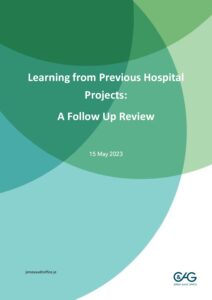
Monday 15 May 2023 - Follow Up Report
Monday 15 May 2023 - Follow Up Report
Topics: Project Delivery
Departments: Health and Community Services
Sector: Health & Social Care

Follow Up Report: pdf (472.19 KB)
Download in full ↓It is not unusual for the delivery of major infrastructure projects to span more than one election cycle. However, it is now over ten years since the States Assembly required the Council of Ministers to bring forward proposals for investment in hospital services, including detailed plans for a new hospital. In that time more than £130 million has been spent on various hospital projects, including on site acquisition and preparatory infrastructure, but with no construction having yet commenced on a new hospital. Almost £39 million of the expenditure incurred has been written off as abortive.
In November 2017 my predecessor reported on Decision Making: Selecting a Site for the Future Hospital (March 2012 – February 2016). The Report identified substantial weaknesses in the decision making process, including in relation to governance, accountabilities, programme management, effective engagement and use of specialist support.
In February 2019, the Future Hospital Project was aborted and in May 2019 the Our Hospital Project was established. Following the 2022 election, a review of the Our Hospital Project was announced. Also referred to as the ‘100-day Review’, it intended to:
‘allow the Government of Jersey to make properly informed decisions about the future of the project; it will assess the direction of travel and consider whether there may be options to deliver a more affordable and appropriate alternative’.
In November 2022 a report (R.154/2022) was published. The key findings reported were that:
In December 2022, the States Assembly approved the removal of the funding allocated to the Our Hospital Project and approved funding to develop detailed feasibility studies to identify a route to delivery for a hybrid, multi-site scheme.
On 28 February 2023, a report (R.32/2023) was presented to the States Assembly. This introduced the New Healthcare Facilities Programme, stating it:
‘represents an evolution of the Our Hospital Project, leveraging the intellectual capital and project products of both the Our Hospital Overdale scheme and the Future Hospital Gloucester Street scheme, applying these to a phased approach with smaller scale delivery stages’.
This Follow Up Review has considered whether the recommendations made in the 2017 C&AG Report have been adopted in the Our Hospital Project, the 100-day Review and the proposed arrangements for the New Healthcare Facilities Programme.
The review has evaluated the extent to which previous C&AG recommendations have been adopted in:
The scope of my work has been limited to considering the areas for improvement identified in the 2017 C&AG Report Decision Making: Selecting a Site for the Future Hospital (March 2012 – February 2016).
In addition, I have documented the expenditure by the States of Jersey and the assets acquired by the States of Jersey since 2012 with respect to new hospital facilities.
Decisions on major capital projects inevitably draw significant public and political interest and the investment in a new hospital is the biggest capital project ever undertaken by the States of Jersey. I have not carried out a comprehensive audit of the elements of the timeline set out at Exhibit 1. My review does not therefore extend for example to:
My review seeks to draw lessons from the 2017 C&AG Report and to make recommendations relevant to the New Healthcare Facilities Programme as it is being established in 2023. In doing so, I have considered:
Over the last ten years more than £130 million has been spent by the States of Jersey on various hospital projects. It is important that the key learning from the previous aborted projects is taken into the New Healthcare Facilities Programme. In particular, there should be a focus on:

Associate Member of EURORAI - a cooperation project between public sector supervisory bodies in Europe